AMD Radeon VII Review: RTX Killer or Flop?
The Radeon VII is AMD's latest GPU offering aimed at gamers, but what you may not realize is that Radeon VII is based on an existing compute product that's been re-purposed for gaming and content cosmos. Based on the Radeon Instinct MI50, the Radeon VII is essentially just gimped Vega 20 silicon, though it'southward not gimped in a way that's meaningful to gamers.
Then what'south been modified then? Double-precision floating-point (FP64) has been disabled, reducing operation from 6.7 TFLOPS down to just i.7 TFLOPS, but this has no affect on gaming. AMD has as well disabled PCIe 4.0, limiting the Radeon Seven to the more than unremarkably used PCIe 3.0 interface, which is non an issue either.
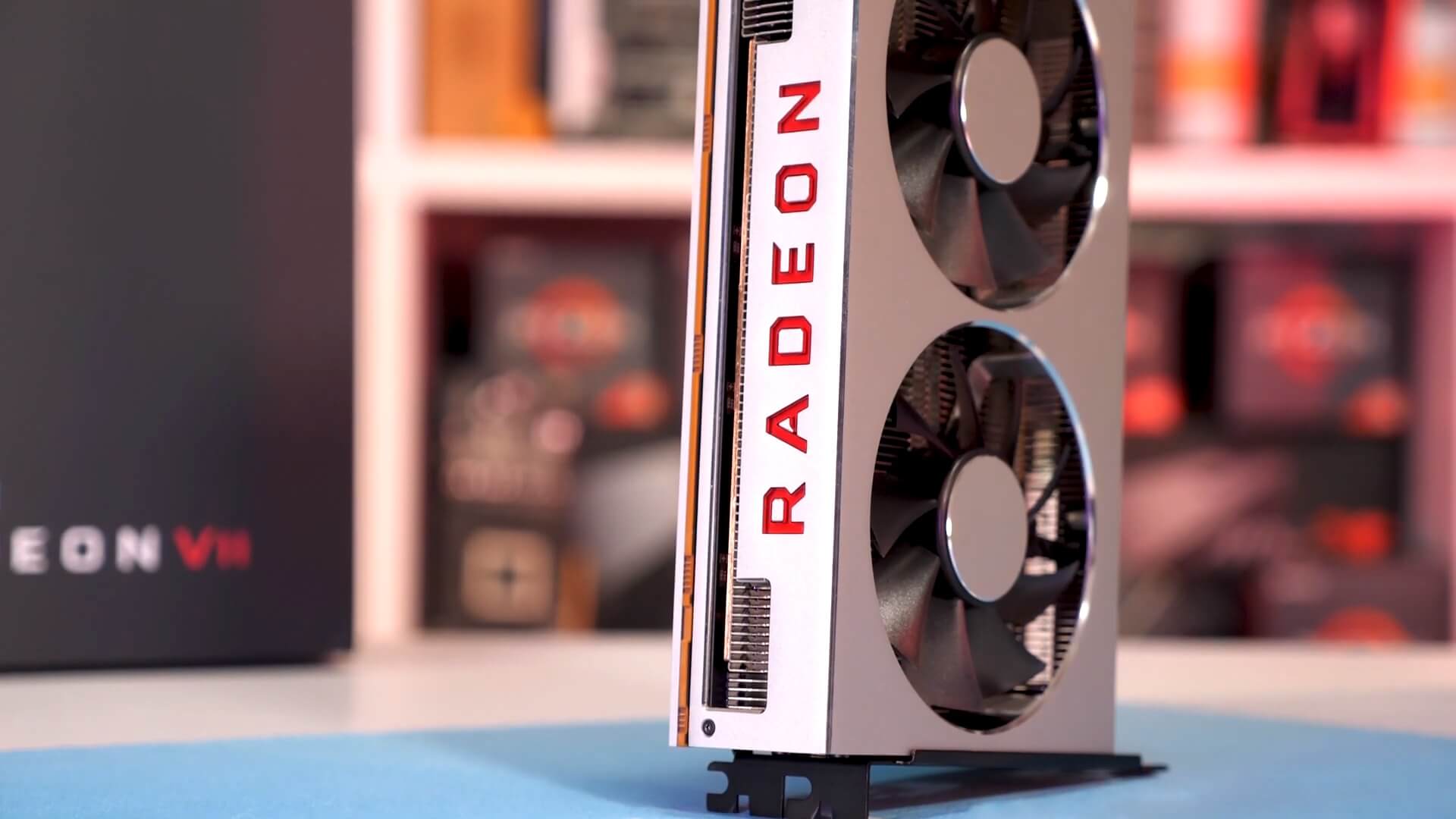
When Radeon Seven was announced at CES a month ago, it wasn't met with a lot of fanfare. Everyone was hoping for AMD's new GPU architecture Navi. So a repurposed compute product wasn't exactly what everyone was clambering up the walls for, and certainly not for $700.
Yes, this is a new 7nm graphics menu, but it's based on 5th-gen GCN architecture, the same used past Vega 56 and Vega 64. The movement from GlobalFoundries' 14nm process to TSMC'due south 7nm FinFET process has allowed AMD to shrink the die size by 32% while also packing in 6% more transistors. Technically Radeon 7 should be chosen Vega 60 or something similar given the specs. What nosotros accept here is 60 compute units for a total of 3840 stream processors, or 6% fewer cores than Vega 64 even though you lot can expect it to be faster.
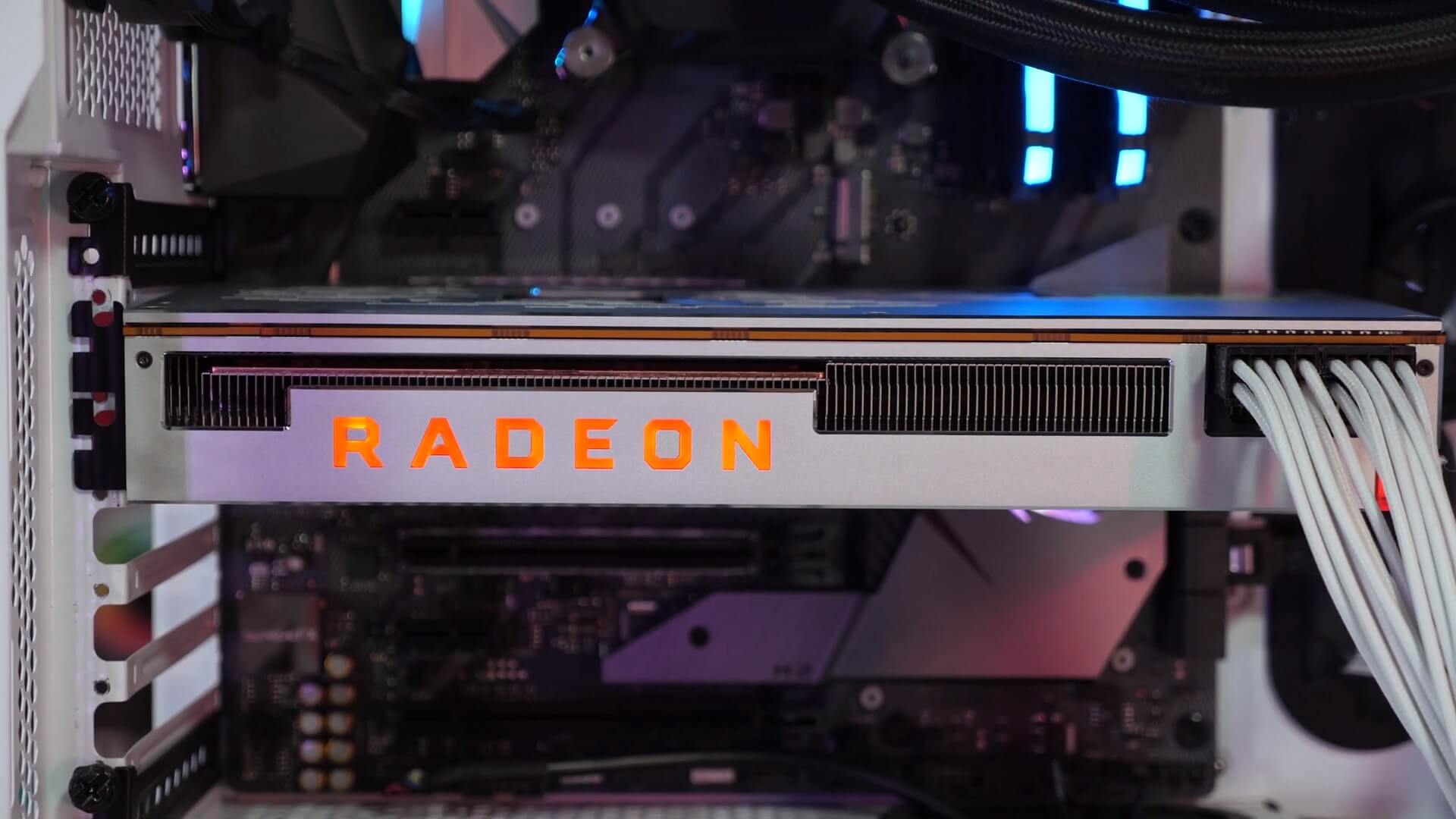
The cores are clocked at to the lowest degree xiii% college and we have some serious memory upgrades and I'm not just talking near the insanely unnecessary (at least for gaming) 16GB VRAM capacity. In addition to having equally much retention as your entire system, the Radeon Seven as well gets a massive 4096-bit broad retention bus, allowing for an insane 1TB/s retentiveness bandwidth, double that of Vega 64.
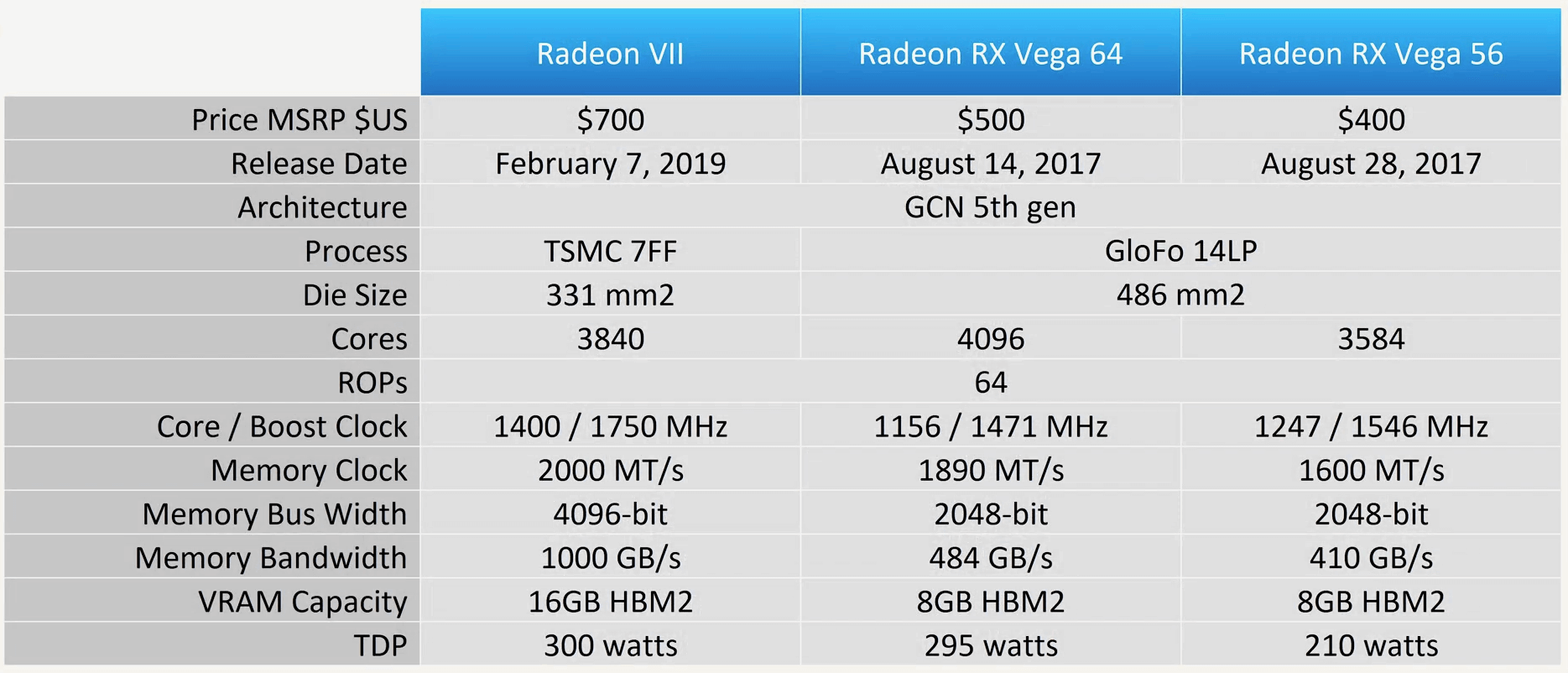
CEO Lisa Su has stated that the Radeon VII performs competitively with Nvidia'due south GeForce RTX 2080 and as such will be bachelor at the same $700 asking toll. Information technology's believed AMD'due south not turning a profit on these things, fifty-fifty at this toll, so we guess nosotros're not going to see them on auction anytime soon.
Our test system for this review was comprised of an Intel Core i9-9900K clocked at v GHz with 32GB of DDR4-3400 memory. While testing the Radeon Vii, nosotros ran into numerous stability bug with the early drivers supplied by AMD and as we pieced this content together, a gear up had yet to be issued.
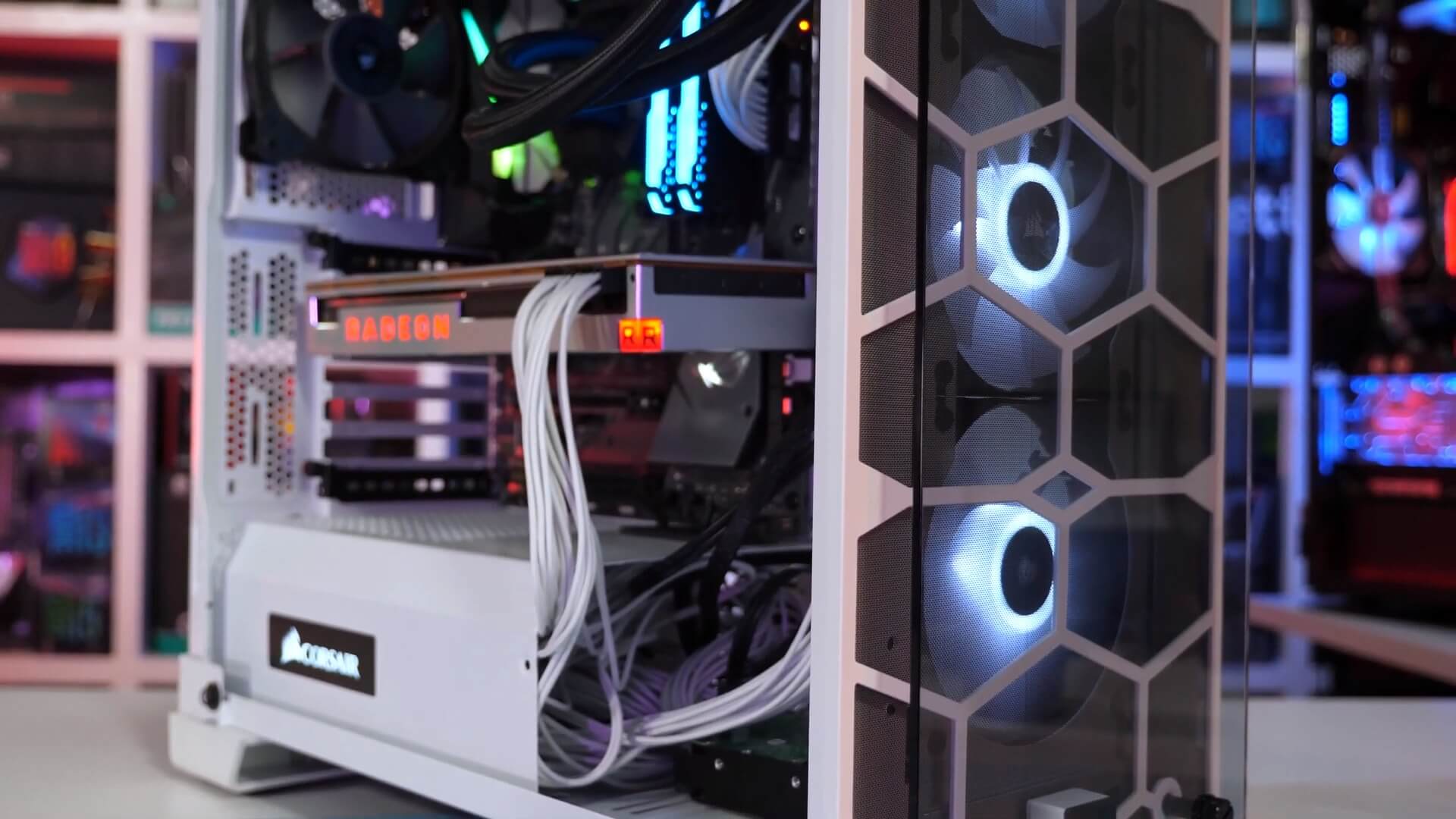
Instead of testing 30+ games nosotros're sticking with a dozen titles that accurately represent how the Radeon 7 performs across a wide range of titles. Once a stable driver has been provided a mega benchmark session will follow with ii or 3 dozen games tested.
Benchmarks
Start upward nosotros have Fortnite and I have to say this is not a good start for Radeon VII as information technology trails the RTX 2080 past xx%. Thankfully, this isn't the norm as yous're most to come across. Simply we practise have a good mix of games that I believe paints a pretty accurate movie of the overall performance.
Fortnite is certainly a worst example scenario as the new Radeon GPU was only able to match the RTX 2070, and it was only 22% faster than Vega 64. It's also a far cry from the at present 2 yr sometime GTX 1080 Ti.

That's a bit brutal so let's move onto some far more promising results.
Battlefield V looks much better. The Radeon 7 slayed in BF5 using the DirectX eleven API, pumping out an impressive 122 fps on average. The i% low performance was a piffling lower than expected merely we do run into a like thing with Vega 64 and 56. When compared to Vega 64 we do see a 31% boost to the boilerplate frame rate then that's quite overnice.
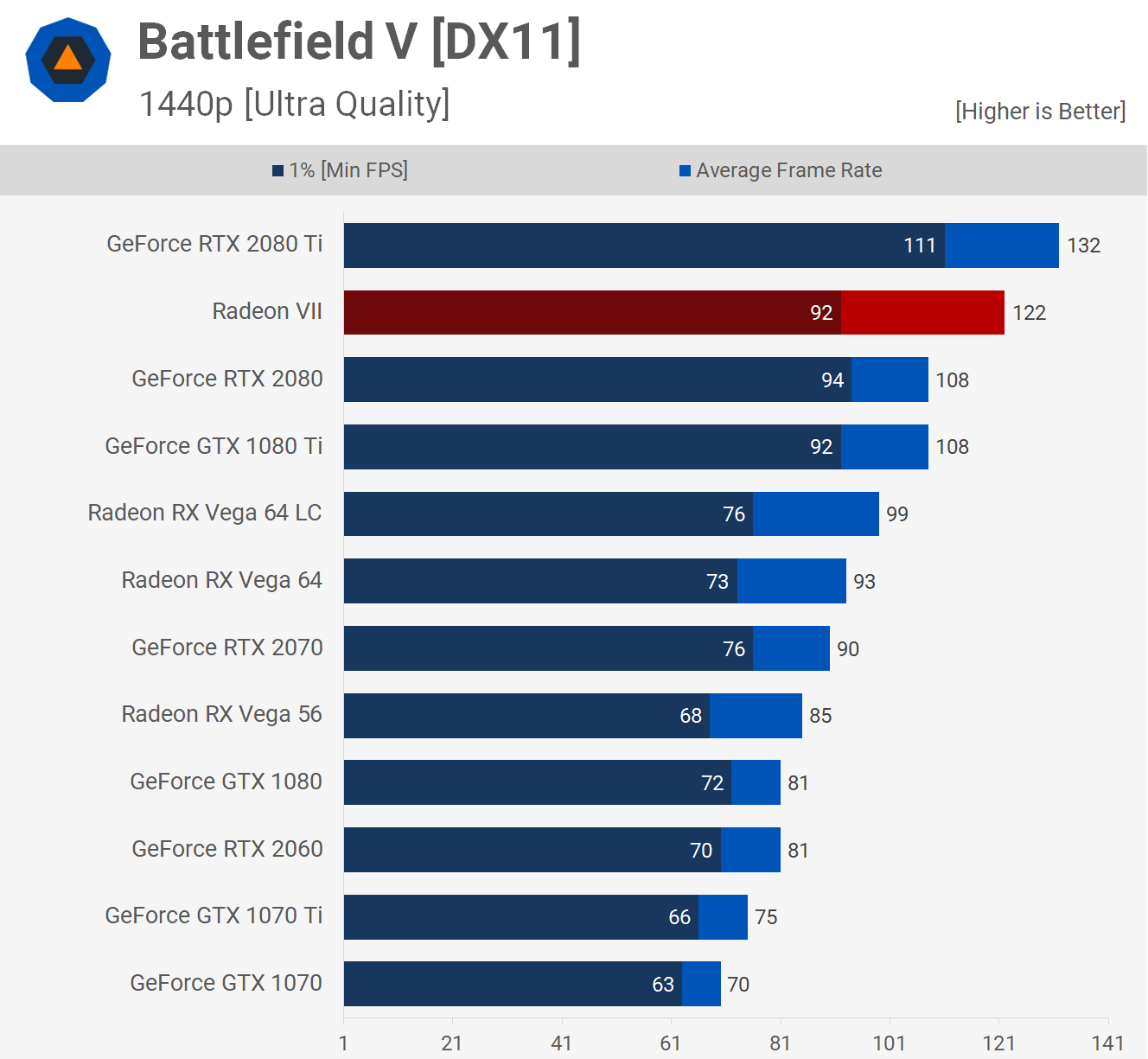
Here nosotros have another title where the Radeon 7 is unable to keep upwards. I mean, 156 fps in World of Tanks is ample performance… simply it besides meant the new Radeon GPU was 17% slower than the RTX 2080 and only slightly faster than the RTX 2070. So a poor effect overall, though Vega never did well in this title and then the issue isn't entirely surprising. Vega 64 merely just beats the GTX 1070 later on all.

A title where the Radeon GPUs shred is Strange Brigade, though like Battlefield 5 we do run across slightly weaker than expected 1% low operation. It's non horrible and in that location was no sign of stuttering but the i% lows are still low relative to the GeForce GPUs. Still when comparing the average frame rate the Radeon Vii was 10% faster than the RTX 2080.

Are you lot starting to notice what we've done here…?
We're giving you lot bad news followed by some proficient news, just trying to allow yous guys down gently is all, I really do intendance. That said it's time for some bad news, Monster Hunter: World sees the Radeon VII fall well behind the RTX 2080, here it's 16% slower and only 7% faster than the RTX 2070, so let's move forth.

The Radeon 7's back on runway for Shadow of the Tomb Raider. Though if you were expecting or at least hoping for an RTX 2080-killer then these results won't exactly send tingles through your spine. It's a few frames faster on average while a few frames down for the 1% low result, so basically it's on par with the RTX 2080 in one of 2018's best looking titles.

Nvidia Turing architecture is well suited to Rainbow Six Siege and where the Radeon GPUs once enjoyed a stiff performance advantage in this title, that's no more. Here the Radeon VII struggled to keep step with the RTX 2080 and in fact was but a whisker ahead of the RTX 2070.

Far Cry 5 is a well optimized title and it also happens to exist sponsored by AMD. I would say this is a adequately even playing field and equally such the Radeon Vii and GeForce RTX 2080 are basically neck and neck.

Forza Horizon 4 is another well optimized championship and while Vega gives the Pascal based GeForce 10 series GPUs a pounding, the new RTX models don't endure from the same weakness and the RTX 2080 was only able to outpace the new Radeon VII.

Resident Evil ii is yet another well optimized title that scales well beyond a wide range of hardware. Hither the RTX 2080 and Radeon Vii are very evenly matched along with the 2 year old GTX 1080 Ti, another $700 part.

We seriously want to drib ARMA 3 from the testing. I've put my foot down and deleted GTA V and how I see it ARMA 3's days are too numbered. It'south basically a dual-core CPU benchmark, and so it's going to skew the results somewhat due to the CPU bottleneck, but given some games are CPU limited information technology's non exactly unrealistic either.
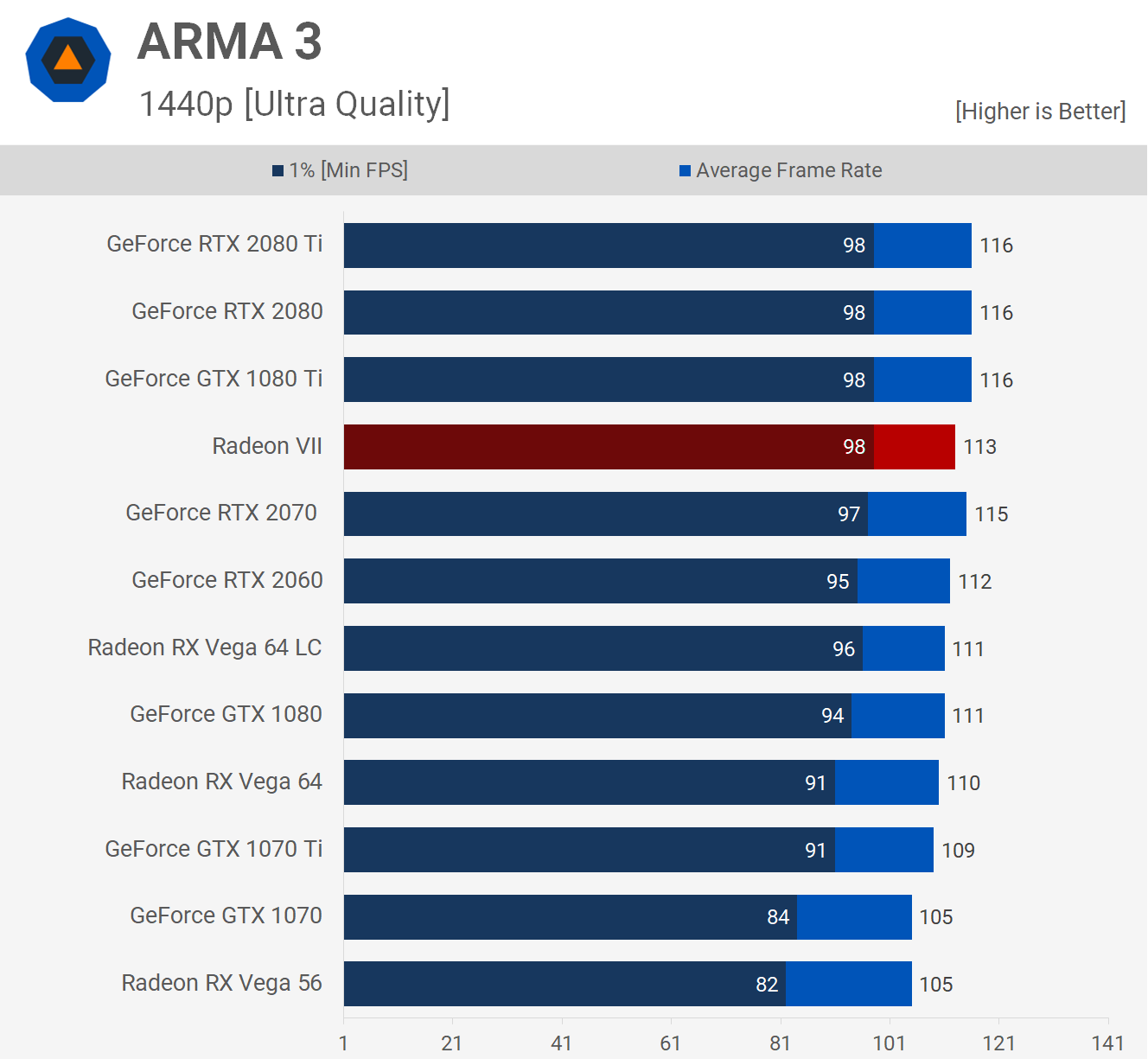
The performance in Hitman is fifty-fifty between the GTX 1080 Ti, RTX 2080 and Radeon VII, though this is a title that's somewhat CPU express at 1440p.

Ability Consumption
We all know AMD's at least a generation behind Nvidia when it comes to efficiency. The Radeon VII is slightly slower than the GTX 1080 Ti, and here we see information technology consumes a whisker more than power that that GPU. Given we're comparison a two year sometime product using TSMC'due south 16nm process to a brand new production using TSMC'due south 7nm process, that'south pretty depressing.

Granted the GTX 1080 Ti is a purpose-congenital gaming graphics card, but at the end of the mean solar day gamers don't care about that. The RTX 2080 is 65% larger and packs roughly the same amount of transistors, yet reduced total system consumption past 15%, for total system consumption that's a meaning number.
Moving on to operating temperatures, the temperatures solitary are okay, comparable to that of the RTX 2080 Founders Edition. The issue is the fan speed required to allow these temperatures...
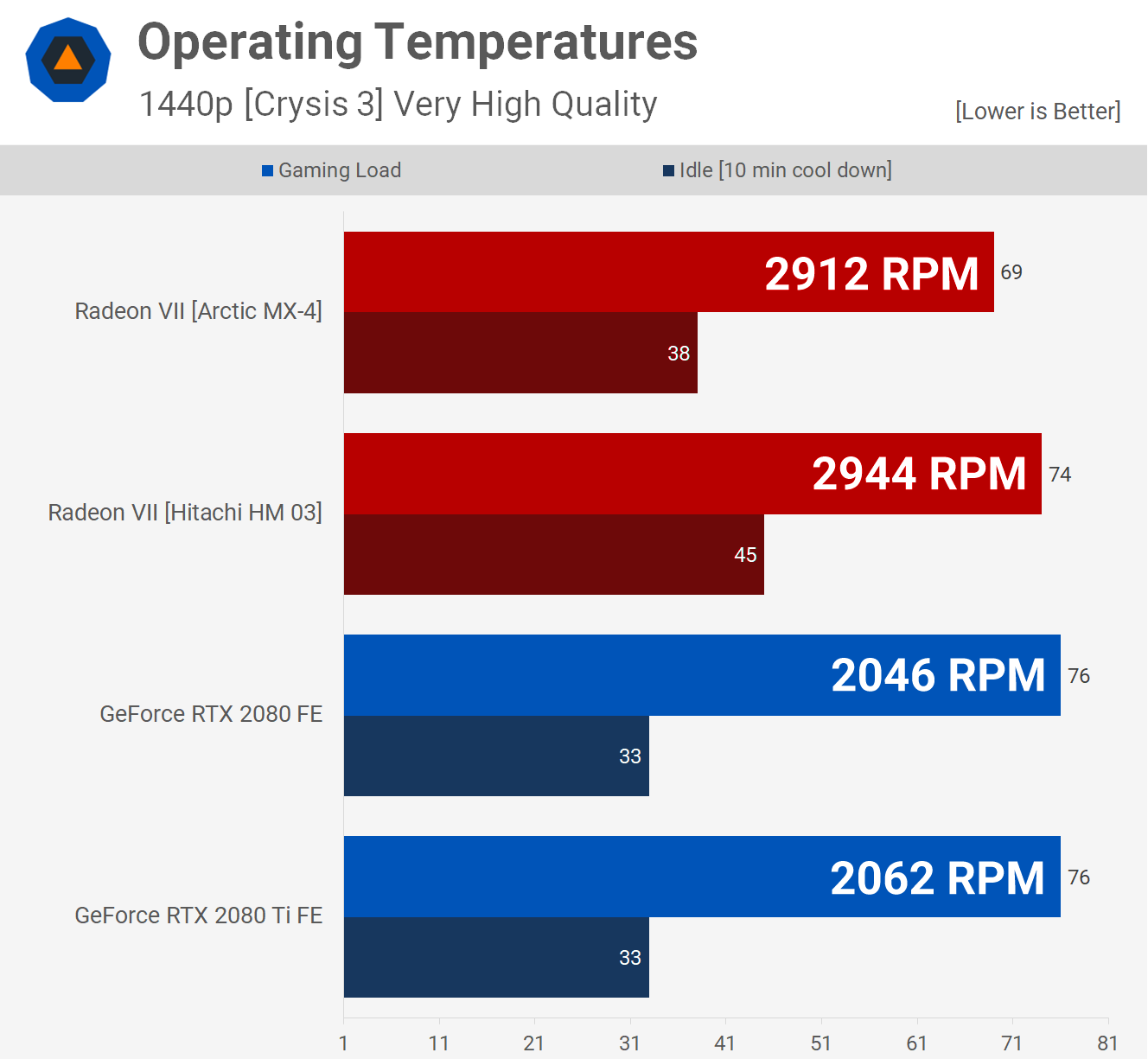
It'south worth mentioning that we replaced the Hitachi HM-03 carbon fiber pads with Arctic's MX-4 thermal paste after tearing the carte down in our unboxing a few days ago.
Out of the box with an ambient room temp of 21 degrees the Radeon 7 hit 74 degrees. However when we went back and re-tested using the thermal paste that temperature under the same weather condition dropped to simply 69 degrees and the fan speed went unchanged.
In other words, the Radeon VII is encarmine loud, fifty-fifty when running at just shy of 70 degrees. As soon as the card was placed under any kind of load, the iii fans spun upwardly to a vacuum cleaner like 2900 RPM. It was at this betoken that I realized, yep this is an AMD reference card, that makes sense. I mean the carte du jour looks cute, but boy is it hard on the ears. Nvidia Founder Edition cards aren't exactly quiet, but the fans only spin at 2000 RPM and they are significantly quieter.
Operation Summary
Before we motion on, please note we haven't tested with more games on our day-1 review as we're not fully confident in the drivers AMD's provided. Every bit mentioned earlier, we are finding them unstable and we've confirmed this with other boyfriend publications. The performance is accurate nonetheless, but before we get crazy on testing dozens of games, we rather await for a more stable driver.
AMD had hinted the Radeon VII is on par with the RTX 2080 and we judge that statement could be true if you cerise picked the games and settings to get them within a percent of ane another. However across our adequately random selection of games -- our whitman's sampler if y'all will -- the Radeon VII was 4% slower on boilerplate. That's still fairly decent, standing out just in Battlefield V and Strange Brigade.

Performance was similar in Shadow of the Tomb Raider, Far Cry 5, Resident Evil 2, Hitman 2 and ARMA 3. Then we saw the Radeon Vii fall behind in Forza Horizon four and then well backside in Rainbow Six Siege, Monster Hunter World, World of Tanks and Fortnite. Given the Radeon 7 arrives at the same $700 MSRP as the RTX 2080, we'd say this is a disappointing outcome.
Moreover, if you were disappointed that the GeForce RTX 2080 was merely slightly faster than the two yr sometime GTX 1080 Ti, then you're no dubiousness disappointed that the Radeon VII is slightly slower. Also, as we saw power consumption isn't improved. In fact, it's slightly worse, so I'thou not sure what more we can say at this point...
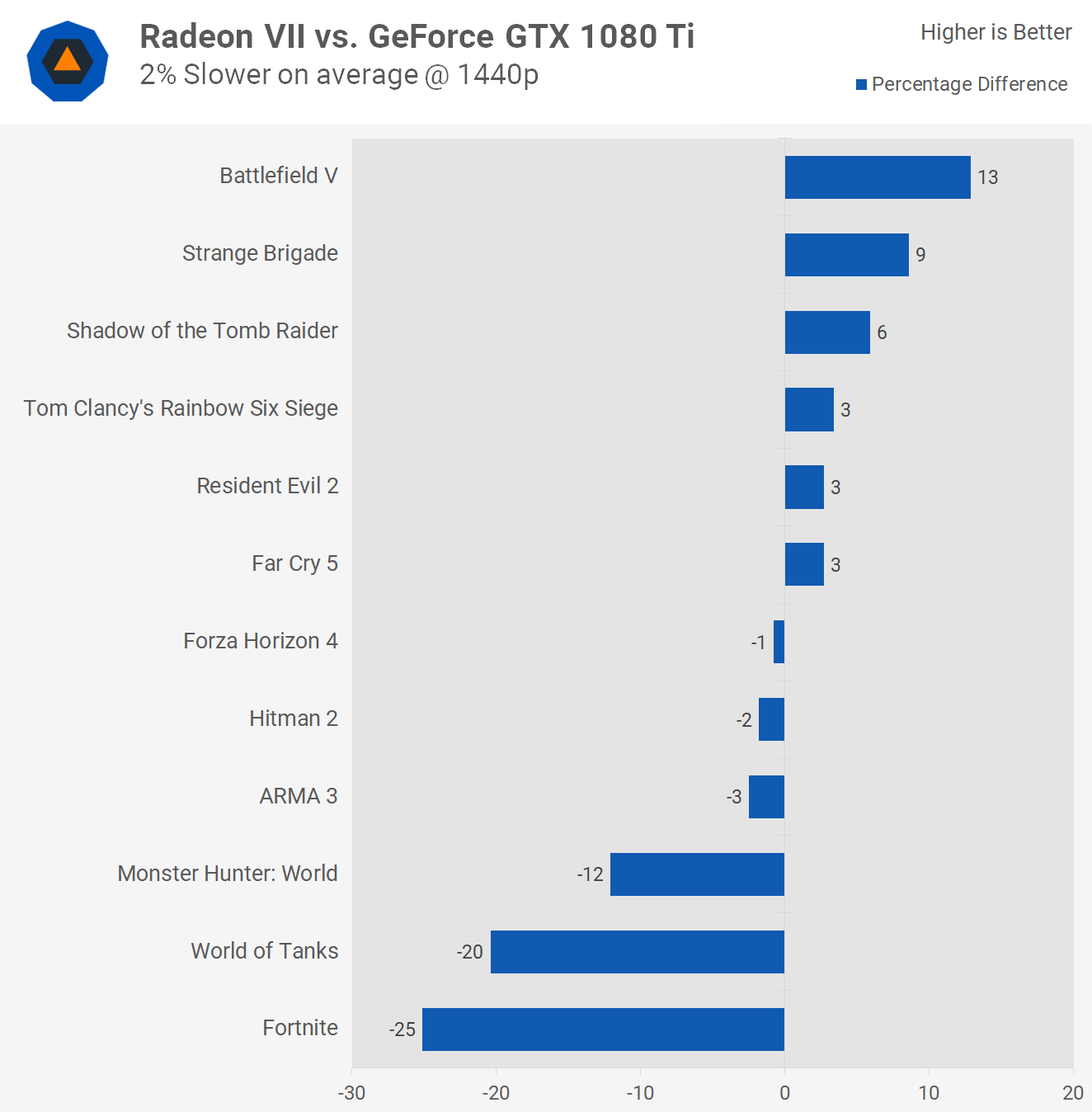
At least the Radeon 7 is a full 31% faster than the RTX 2060. You merely have to close your optics and ignore the fact that information technology costs 100% more. Or peradventure relatively soon we'll see Radeon VII selling on the street for something closer to $600 where information technology's meliorate value and makes somewhat better sense.

Vega 64 comes at a $500 MSRP, making the Radeon VII forty% more expensive only it's but 23% faster. That's even worse than RTX boards. The merely saving grace hither is that AMD hasn't tried to sell usa on a technology that won't deliver, while effectively scamming customers with a month long pre-society period… gotta await on the brilliant side guys.

Cost per Frame and Endmost Thoughts
We're non fifty-fifty going to try and sugar coat information technology -- not that nosotros e'er practise -- I guess I'm just getting over disappointing GPU releases. Looking at cost per frame information, naturally it'due south worse value than the RTX 2080 and despite existence faster than Vega 56 and 64, information technology'south way worse value.
Frankly nosotros would rather reject a few quality settings and enjoy the almost 25% improvement in value with Vega 56, or but get an RTX 2060 given it's slightly faster and slightly cheaper, and then I'd merely smiling as Radeon 7 owners tell me 6GB of VRAM isn't enough.

At this point you might be wondering where the overclocking performance is, but unfortunately we accept nothing for yous right at present. AMD's WattMan is cleaved and it just made my already unstable card even more unstable. So this is something we'll have to revisit afterward on. Update: AMD released new Radeon Seven drivers that address all stability issues on release mean solar day ane. Operation is the same, but at least anyone who bought this menu should enjoy a flawless experience. We've updated our review score as a result.
There's also that massive 16GB frame buffer and insane 1TB/s memory bandwidth which could be beneficial for content creators and other GPU accelerated applications.
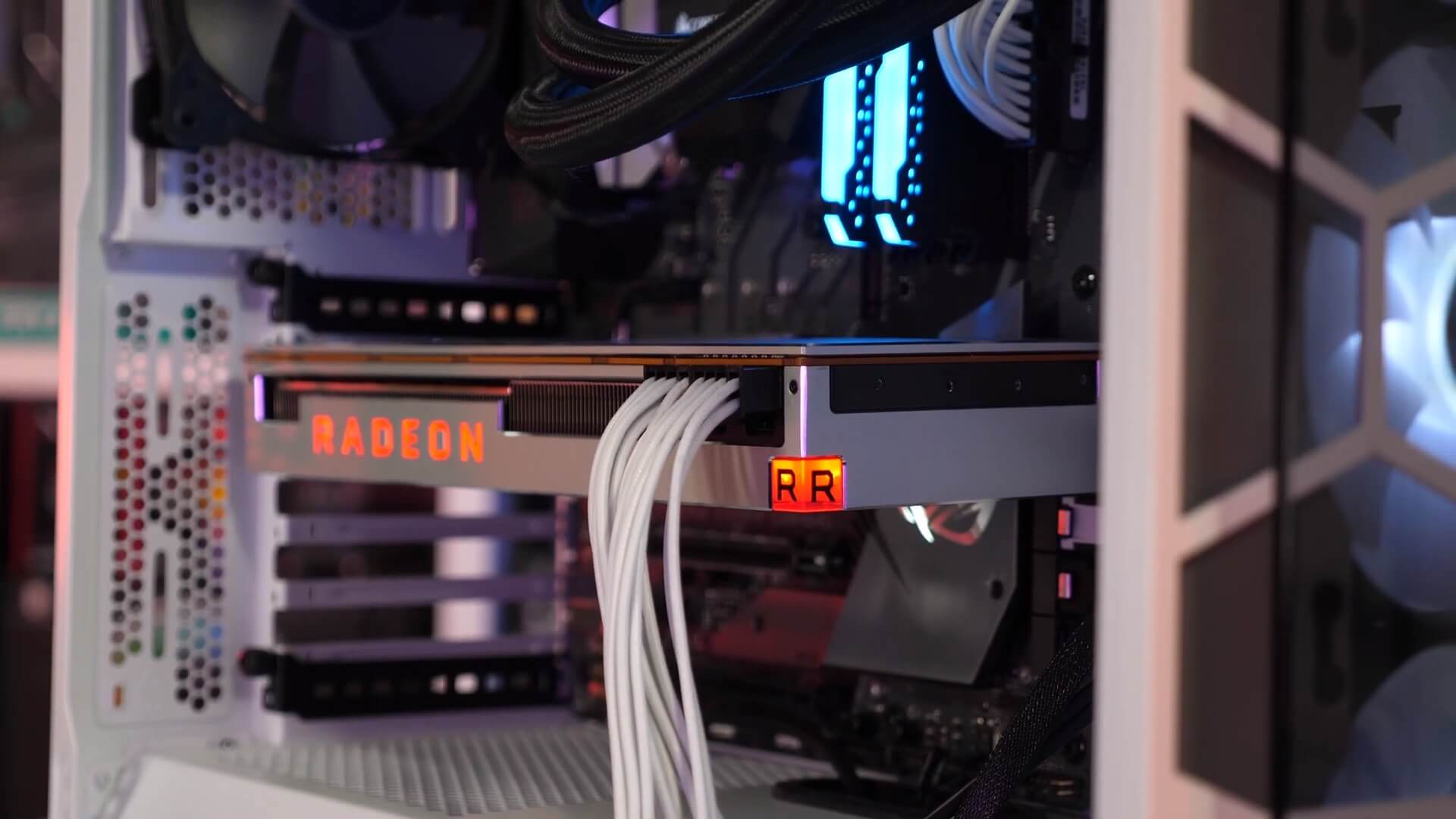
Another issue for Radeon Vii will be availability. The retailers we've spoken to take said availability'due south much worse than what we saw with the RTX 2080 Ti upon release. So while nosotros suspect demand for this new Radeon GPU will exist low, product might be even lower. As such we're not sure if or when nosotros'll see custom AIB models. AMD has told us AIBs are gratuitous to develop their own models, but we doubtable few will. We saw this happen with Vega, there merely wasn't plenty book and demand to warrant the investment from board partners.
It's worth mentioning that AMD is offer an attractive game package with free copies of the Resident Evil ii remake, The Division two, and Devil May Cry 5 shipping with every Radeon 7 menu. Though it's difficult to compare with other bundles since these change all the time, it's a good one AMD is offer at launch.

Bottom line, Radeon VII looks to be nothing more than a stop gap to the now heavily delayed Navi. It's a way for AMD to stick their hand up half way and say we're still here guys, don't forget about us. The but hope for the Radeon VII now is that product costs will come up downward over the coming months and they can beginning to edge down to $600. It's a big enquire, and even in that location information technology would become just slightly better value than Vega 64 and the RTX 2080.
This is not peachy news for gamers wanting good value on high-end GPUs. AMD besides needs a miracle with Navi. A lot's riding on that one, merely given what they've achieved with Ryzen, we strongly believe annihilation is possible.
Shopping Shortcuts:
- GeForce RTX 2060 on Amazon, Newegg
- GeForce RTX 2070 on Amazon, Newegg
- GeForce RTX 2080 on Amazon, Newegg
- GeForce RTX 2080 Ti on Amazon, Newegg
- Radeon RX Vega 56 on Amazon, Newegg
- Radeon RX Vega 64 on Amazon, Newegg
- Radeon RX 570 on Amazon, Newegg
- Radeon RX 580 on Amazon, Newegg
Pros: Faster Radeon graphics, yay! AMD fans become a faster GPU but yous're going to accept to pay for it and it'southward not improve than the competition. Massive 16GB frame buffer and insane 1TB/s memory bandwidth must be good for something.
Cons: Radeon VII runs hot and loud. Value is worse than RTX cards, and you don't fifty-fifty go the do good of the dubiousness of DLSS or ray tracing for the extra money. Early drivers could hateful more operation down the line. If not, AMD volition take to cut pricing by at to the lowest degree $100.
Source: https://www.techspot.com/review/1789-amd-radeon-vii/
Posted by: huckabeesernis.blogspot.com


0 Response to "AMD Radeon VII Review: RTX Killer or Flop?"
Post a Comment